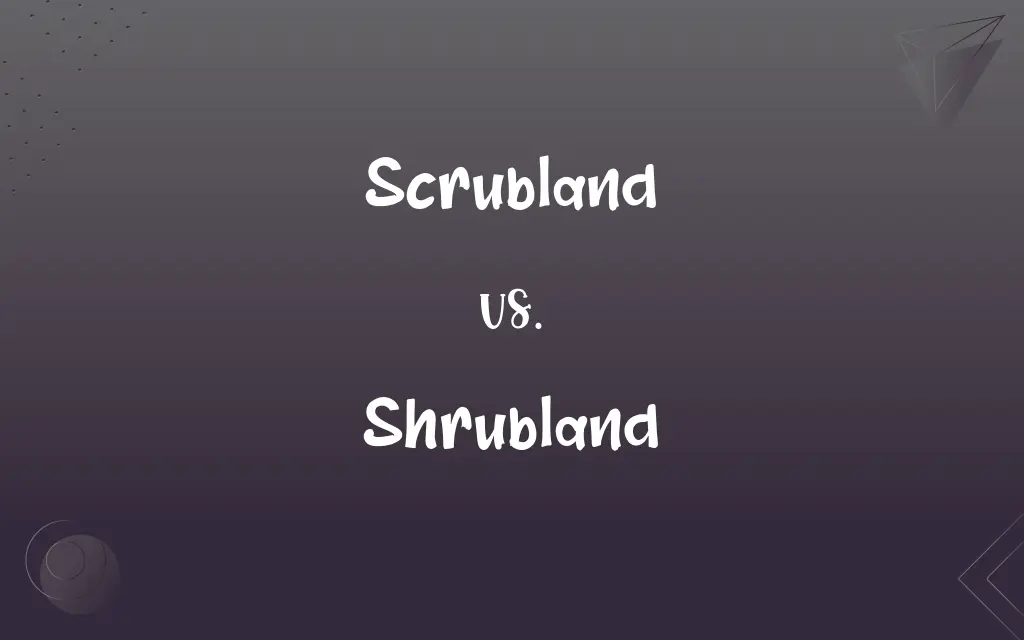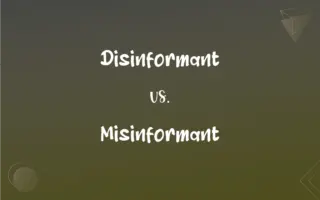Scrubland vs. Shrubland: What's the Difference?
By Harlon Moss || Updated on May 24, 2024
Scrubland refers to areas dominated by stunted, often thorny vegetation and sparse trees, while shrubland describes regions primarily covered with shrubs, which are woody plants with multiple stems.

Key Differences
Scrubland is characterized by low-growing, often dense and thorny vegetation, and may include sparse trees and grasses. This type of landscape typically arises in regions with poor soil quality, limited water availability, or after land degradation. Shrubland, on the other hand, is dominated by shrubs woody plants with multiple stems that are shorter than trees. Shrublands can be found in various climates, from Mediterranean regions to temperate zones, and they often support a diverse range of plant and animal species.
In terms of usage, scrubland is often associated with wastelands or areas that are less favorable for agriculture due to their harsh conditions. These landscapes can serve as grazing land for livestock. Shrubland, meanwhile, can represent a transitional stage between grassland and forest or can be a stable ecosystem in its own right. Shrublands are important for conservation efforts as they provide habitat for numerous species.
The plant composition in scrublands tends to be more hardy and adapted to extreme conditions, including drought and poor soils. Shrublands generally support a wider variety of plant life, including many species of shrubs that provide important ecological functions, such as erosion control and habitat for wildlife.
Comparison Chart
Definition
Area with stunted, often thorny vegetation and sparse trees
Area covered primarily with shrubs, which are woody plants with multiple stems
Vegetation Type
Hardy, low-growing, thorny plants
Shrubs, woody plants with multiple stems
ADVERTISEMENT
Soil Quality
Typically poor
Can vary from poor to fertile
Water Availability
Limited
Can range from limited to moderate
Ecological Stability
Often less stable, prone to degradation
More stable, supports diverse species
Common Plants
Cacti, thorn bushes
Sagebrush, heath
Usage
Grazing land, often less favorable for agriculture
Conservation, transitional ecosystems
ADVERTISEMENT
Habitat Importance
Less diverse, hardy species
High biodiversity, important for conservation
Scrubland and Shrubland Definitions
Scrubland
Area with stunted, often thorny vegetation.
The desert scrubland was dotted with hardy cacti and thorn bushes.
Shrubland
Area covered primarily with shrubs.
The Mediterranean shrubland was rich with aromatic sagebrush.
Scrubland
Land covered with low, dense shrubs.
They hiked through the scrubland, navigating the thick underbrush.
Shrubland
Region where shrubs are the dominant vegetation.
Shrublands provide a crucial habitat for many bird species.
Scrubland
Region characterized by poor soil and limited water.
The farmers struggled to cultivate the arid scrubland.
Shrubland
Often more ecologically stable than scrubland.
Conservationists worked to protect the delicate shrubland ecosystem.
Scrubland
Land that is often used for grazing livestock.
The goats foraged in the scrubland for sparse vegetation.
Shrubland
Can be found in various climates.
The temperate shrubland supported a diverse ecosystem.
Scrubland
Typically found in arid or semi-arid regions.
Scrubland stretches across much of the Australian outback.
Shrubland
Important for erosion control and habitat provision.
The shrubland helped prevent soil erosion on the hillside.
Scrubland
An area of land that is uncultivated and covered with sparse stunted vegetation.
Shrubland
An area, such as chaparral, covered chiefly with shrubs and small trees.
Scrubland
A plant community characterized by scrub vegetation, consisting of low shrubs, mixed with grasses, herbs, and geophytes.
The scrubland I'd be crossing looked desolate, but at least it wasn't a desert.
Shrubland
(mostly plural) Land that is covered mostly with shrubs.
Scrubland
An uncultivated region covered with scrub vegetation
FAQs
How does vegetation differ between scrubland and shrubland?
Scrubland has hardy, low-growing, often thorny plants, while shrubland is dominated by woody shrubs with multiple stems.
Is shrubland more ecologically stable than scrubland?
Yes, shrubland is generally more ecologically stable and supports a diverse range of species.
What does shrubland mean?
Shrubland describes a region primarily covered with shrubs, which are woody plants with multiple stems.
What does scrubland mean?
Scrubland refers to an area with stunted, often thorny vegetation and sparse trees.
Which type of land has poorer soil quality?
Scrubland typically has poorer soil quality compared to shrubland.
Can scrubland be used for agriculture?
Scrubland is often less favorable for agriculture due to harsh conditions, but it can be used for grazing livestock.
Is scrubland important for biodiversity?
Scrubland is generally less diverse but supports hardy species adapted to harsh conditions.
Where is scrubland typically found?
Scrubland is typically found in arid or semi-arid regions.
What types of plants are common in scrubland?
Common plants in scrubland include cacti and thorn bushes.
What types of plants are common in shrubland?
Common plants in shrubland include sagebrush and heath.
Is shrubland important for conservation?
Yes, shrubland is important for conservation as it provides habitat for numerous species.
Are scrubland and shrubland the same?
No, scrubland and shrubland are different; scrubland is characterized by stunted, often thorny vegetation, while shrubland is dominated by woody shrubs.
How does water availability differ between scrubland and shrubland?
Scrubland typically has limited water availability, while shrubland can range from limited to moderate water availability.
What is an example of scrubland?
E.g., The desert scrubland was dotted with hardy cacti and thorn bushes.
Which type of land is more likely to support diverse wildlife?
Shrubland is more likely to support diverse wildlife compared to scrubland.
Can scrubland and shrubland coexist in the same region?
Yes, both types of land can coexist in the same region, often transitioning from one to the other based on soil and water conditions.
Where can shrubland be found?
Shrubland can be found in various climates, from Mediterranean regions to temperate zones.
Can shrubland prevent soil erosion?
Yes, shrubland plays an important role in preventing soil erosion.
What is an example of shrubland?
E.g., The Mediterranean shrubland was rich with aromatic sagebrush.
Do scrubland and shrubland have different ecological functions?
Yes, scrubland often serves as grazing land, while shrubland supports a wider range of ecological functions, including habitat provision and erosion control.
About Author
Written by
Harlon MossHarlon is a seasoned quality moderator and accomplished content writer for Difference Wiki. An alumnus of the prestigious University of California, he earned his degree in Computer Science. Leveraging his academic background, Harlon brings a meticulous and informed perspective to his work, ensuring content accuracy and excellence.
































































